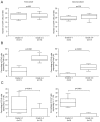Th17/Treg ratio in human graft-versus-host disease
- PMID: 20484086
- PMCID: PMC3001485
- DOI: 10.1182/blood-2009-12-255810
Th17/Treg ratio in human graft-versus-host disease
Abstract
Th17 cells have never been explored in human graft-versus-host disease (GVHD). We studied the correlation between the presence of Th17 cells with histologic and clinical parameters. We first analyzed a cohort of 40 patients with GVHD of the gastrointestinal tract. Tumor necrosis factor (TNF), TNF receptors, and Fas expression, and apoptotic cells, CD4(+)IL-17(+) cells (Th17), and CD4(+)Foxp3(+) cells (Treg) were quantified. A Th17/Treg ratio less than 1 correlated both with the clinical diagnosis (P < .001) and more than 2 pathologic grades (P < .001). A Th17/Treg ratio less than 1 also correlated with the intensity of apoptosis of epithelial cells (P = .03), Fas expression in the cellular infiltrate (P = .003), TNF, and TNF receptor expression (P < .001). We then assessed Th17/Treg ratio in 2 other independent cohorts; a second cohort of 30 patients and confirmed that Th17/Treg ratio less than 1 correlated with the pathologic grade of GI GVHD. Finally, 15 patients with skin GVHD and 11 patients with skin rash but without pathologic GVHD were studied. Results in this third cohort of patients with skin disease confirmed those found in patients with GI GVHD. These analyses in 96 patients suggest that Th17/Treg ratio could be a sensitive and specific pathologic in situ biomarker of GVHD.
Figures







References
Publication types
MeSH terms
Substances
LinkOut - more resources
Full Text Sources
Other Literature Sources
Medical
Research Materials
Miscellaneous

